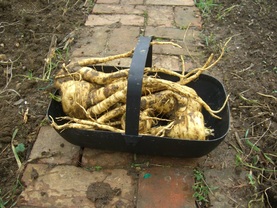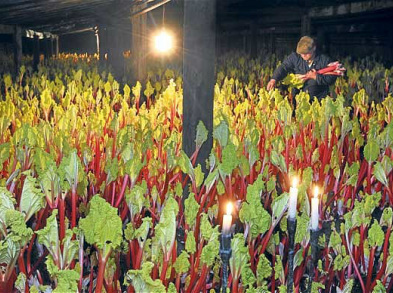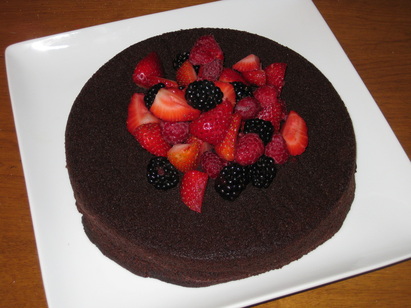 Herb window box, dreaming of summer
Herb window box, dreaming of summer Joyous tidings of spring today, with birds singing and temperatures warm enough to walk outside without a jacket. Frozen snow is still coating the ground, but in the greenhouse it's still possible to rub mint leaves between your fingers and imagine summer.
Herbs have always been part of our medicinal, culinary and folkloric repertoire and are now regaining great popularity. Beneath the snow I'm hoping the perennial herbs are surviving and am looking forward to their color, texture and perfume when they emerge. Last fall I potted up a few varieties of these stalwarts in well-drained compost and have them in pots on my windowsill so I can use them in recipes throughout the winter.
Rosemary is Queen of the winter greenhouse herbs. Introduced by the Romans, it is a flavorsome partner to garlic and lemon, is great with lamb, chicken or a pan of roast mixed vegetables. It's easy to add a few sprigs to a bottle of supermarket olive oil as a pick-me-up to baste or drizzle over winter salads.
Sage is traditionally used in stuffings or bread sauce. It's also delicious with pared lemon rind, pine nuts, mushrooms and garlic with poultry. To add flavor to winter salad dressings try macerating a leaf in a bottle of white balsamic or cider vinegar with a few juniper berries. I'm fond of the golden, chartreuse and purple varieties which brighten up any beds inside or out.
Thyme is great chopped and added to an aromatic winter salad of radicchio with lentils, another simple recipe is to beat together a few sprigs with 12oz of white beans, two crushed cloves of garlic and some chili to taste, then slowly pour in olive oil and the juice of half a lemon. Season with salt and pepper and eat with toasted sourdough bread. I also grow lemon thyme which is wonderful when stripped of its stems and pounded into a gremolade with lemon zest, garlic and sea salt to eat with sauteed fish. Outside, thyme can be used to creep it's fragrant way into the most unwelcoming spots.
Bay leaves are delicious fresh. Add a few leaves to a jam jar of sugar to flavour rice puddings, or add a sprig of rosemary, lavender or a vanilla pod instead. Gather all four herbs together to make a bouquet garni, and add to a slow-cooked tomato purée with a little brown sugar for pasta, or just use a bunch to decorate your kitchen table.
WInter Savory, another easy indoor winter herb, is wonderfully aromatic on good bread toasted with goat's cheese and drizzled with olive oil.
Chervil, pale green, frilly, and delicious as a topping for creamy scrambled eggs.
Strong cheese, like goat’s cheese, works well with pungent herbs. Try marinating a few round crottins with sprigs of thyme, rosemary or savoury in a jar, with shallots, chilli peppers and garlic. Top up with oil and leave for a month.
One of my favorite pasta recipes is memorized from an old Italian cookbook. The original version called for a lavish assortment of ten chopped herbs warmed gently in a pan of olive oil for a few minutes, until the herbs turned vibrant green. I've experimented with a tablespoon each of chopped parsley, garlic chives, chervil, sage, marjoram and thyme, a chopped garlic clove and dried chilli with ground black pepper. Spoon over a dish of hot linguini.
Herbs have always been part of our medicinal, culinary and folkloric repertoire and are now regaining great popularity. Beneath the snow I'm hoping the perennial herbs are surviving and am looking forward to their color, texture and perfume when they emerge. Last fall I potted up a few varieties of these stalwarts in well-drained compost and have them in pots on my windowsill so I can use them in recipes throughout the winter.
Rosemary is Queen of the winter greenhouse herbs. Introduced by the Romans, it is a flavorsome partner to garlic and lemon, is great with lamb, chicken or a pan of roast mixed vegetables. It's easy to add a few sprigs to a bottle of supermarket olive oil as a pick-me-up to baste or drizzle over winter salads.
Sage is traditionally used in stuffings or bread sauce. It's also delicious with pared lemon rind, pine nuts, mushrooms and garlic with poultry. To add flavor to winter salad dressings try macerating a leaf in a bottle of white balsamic or cider vinegar with a few juniper berries. I'm fond of the golden, chartreuse and purple varieties which brighten up any beds inside or out.
Thyme is great chopped and added to an aromatic winter salad of radicchio with lentils, another simple recipe is to beat together a few sprigs with 12oz of white beans, two crushed cloves of garlic and some chili to taste, then slowly pour in olive oil and the juice of half a lemon. Season with salt and pepper and eat with toasted sourdough bread. I also grow lemon thyme which is wonderful when stripped of its stems and pounded into a gremolade with lemon zest, garlic and sea salt to eat with sauteed fish. Outside, thyme can be used to creep it's fragrant way into the most unwelcoming spots.
Bay leaves are delicious fresh. Add a few leaves to a jam jar of sugar to flavour rice puddings, or add a sprig of rosemary, lavender or a vanilla pod instead. Gather all four herbs together to make a bouquet garni, and add to a slow-cooked tomato purée with a little brown sugar for pasta, or just use a bunch to decorate your kitchen table.
WInter Savory, another easy indoor winter herb, is wonderfully aromatic on good bread toasted with goat's cheese and drizzled with olive oil.
Chervil, pale green, frilly, and delicious as a topping for creamy scrambled eggs.
Strong cheese, like goat’s cheese, works well with pungent herbs. Try marinating a few round crottins with sprigs of thyme, rosemary or savoury in a jar, with shallots, chilli peppers and garlic. Top up with oil and leave for a month.
One of my favorite pasta recipes is memorized from an old Italian cookbook. The original version called for a lavish assortment of ten chopped herbs warmed gently in a pan of olive oil for a few minutes, until the herbs turned vibrant green. I've experimented with a tablespoon each of chopped parsley, garlic chives, chervil, sage, marjoram and thyme, a chopped garlic clove and dried chilli with ground black pepper. Spoon over a dish of hot linguini.



 RSS Feed
RSS Feed
